Hungarian Lángos
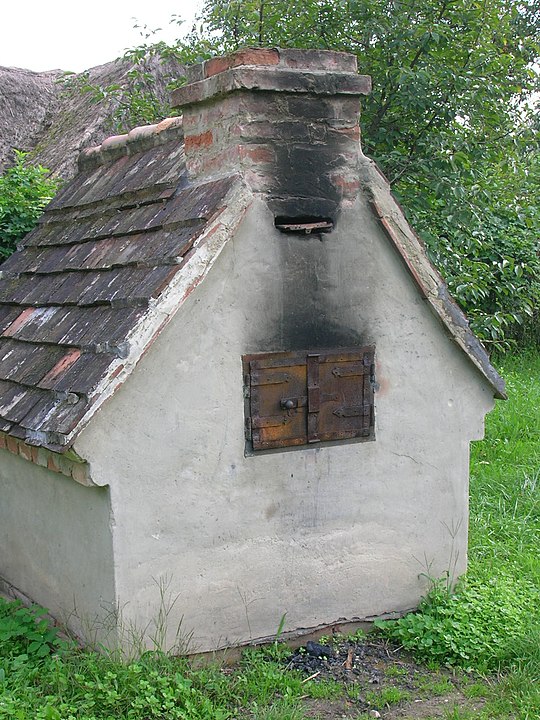
In Hungary, and indeed in places all over the world, it was once common practice for the residents of smaller villages to bring their bread dough to a community oven for baking. The bakehouse was–and still is in some parts of the world–a sort of de facto community center, a gathering place where news was shared between families.
Even in places or times where (or when) community baking in Hungary was uncommon, there was still a strong home-baking culture. That is, until the mid-20th Century, when, according to the linked essay, cultural changes–state ownership of farms and their products, more young people working outside the home and fewer, aging hands to knead the dough–contributed to an increase in the purchase of prepared foods, including bread.
According to Atlas Obscura among other sources, Lángos originated back in those before times, the days when Hungarians commonly baked their own bread, whether at home or at the village bakehouse. The word lángos derives from láng, or flame. When the home-risen bread dough was ready to be baked, a piece was cut off and tossed in the fire at home to be baked quickly, then eaten for a breakfast meal, topped with sour cream or jam.
These days lángos, sometimes called Hungarian pizza, is mostly served as a street food. Deep-fried rather than fire-baked, it is a flatbread, often made with potato, that is usually topped with some combination of garlic, sour cream, and shredded cheese. The closest place I can find that serves it is in Cleveland, which has one of the largest concentrations of Hungarian people in the US. I for one am up for a return visit to Cleveland, as we had a great time there a few years ago eating the local sausage sandwich called Polish Boy. But that visit is just not in the cards this month, alas! However, I have bread flour, and potatoes, and frying oil, and two hands that are somewhat aged but still good for kneading dough. I also have a KitchenAid and will probably use that to knead it instead.
There are a lot of recipes out there for lángos, and not all of them include potato, though that type does seem fairly traditional. In seeking out recipes for traditional potato lángos, I found my best bet was recipes in the Hungarian language like this one. Because of the previously-noted caprices of machine translation, even the Google translation of this recipe requires a little interpretation. Here’s mine:
Lángos
Ingredients
- 500 g bread flour
- 1 russet potato approximately 200 grams
- 200 ml milk lukewarm
- 1 packet active dry yeast
- 1 tsp sugar
- 1.5 tsp salt
- frying oil I used canola
Instructions
- Boil the russet potato until soft, then cool until it is room temperature. Mash finely or rice and add to flour and salt in a large bowl
- Heat the milk for just a few seconds in a microwave until it is lukewarm. Mix in the sugar and bloom the yeast in this mixture.
- Combine the wet and dry ingredients in the mixer bowl and mix until it comes together. If you need to, add just a tiny bit of water but not much.
- Knead until the dough is smooth and supple. This took me around 15 minutes at medium speed in my KitchenAid, along with a few sessions of manual kneading on the tabletop.
- Put dough intp oiled bowl. Cover and let rise for 45 minutes to an hour
- Divide into 8 equal pieces, pinch closed on bottom and roll into a round breadroll shape.
- Keeping the pieces you are not working with covered, pat out and flatten each breadroll shape and roll out to a circle around 6″ in diameter, then cover.
- Proof the flattened dough for 20-30 minutes while the oil heats to ~350° F.
- Working with one dough disk at a time, stretch them like a pizza dough, starting with your hands in a steering wheel orientation, then moving to using your knuckles. Stretch each piece of dough to 8″ or 9″ in diameter, so that it has a thin center with a slightly thicker outer rim like a less pronounced cornicione.
- Fry the dough for a couple of minutes on each side until nicely brown in color.
Notes
- Original source: https://www.nosalty.hu/recept/burgonyas-langos
- If you won’t be using all the dough right away, sprinkle some extra flour on the excess, bag it, and put it in the fridge until you’re ready to work with it. This can be done immediately before or after step 6.
- Make a slit in the center of each Lángos to let steam escape so it can cook more evenly
- Top with garlic, sour cream and shredded cheese, or any number of other combinations.
Many of the more authentic recipes I found called for rolling the whole mess of dough out and using a plate to cut it into round sections but I prefer the method I described. Some recipes called for cutting slits into the center of the dough, calling it a traditional practice. Many of the Hungarian recipes I looked at did not mention this step. However, it’s easy to see why one would do it.
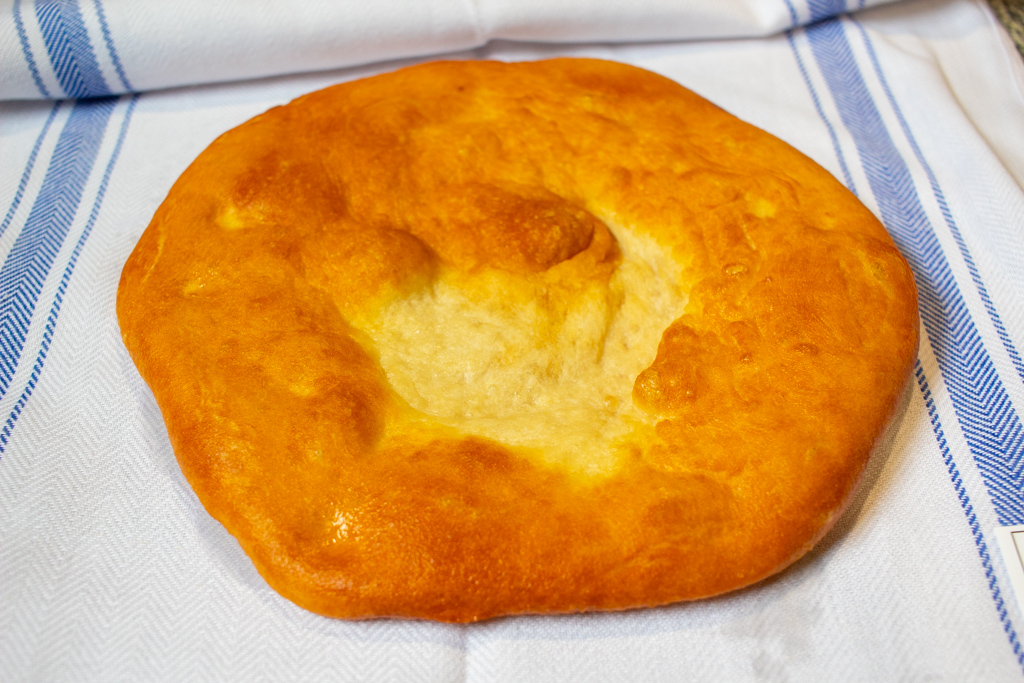
Without any way for steam to escape, it gathers underneath the center of the flatbread and balloons it up out of the oil, causing the center to be lighter in color than the rest of the bread. This must be why donuts have holes in them. You can combat this by using a utensil of some kind to hold the center section down in the oil but I was able to achieve more consistent results by cutting the described slit in the dough.
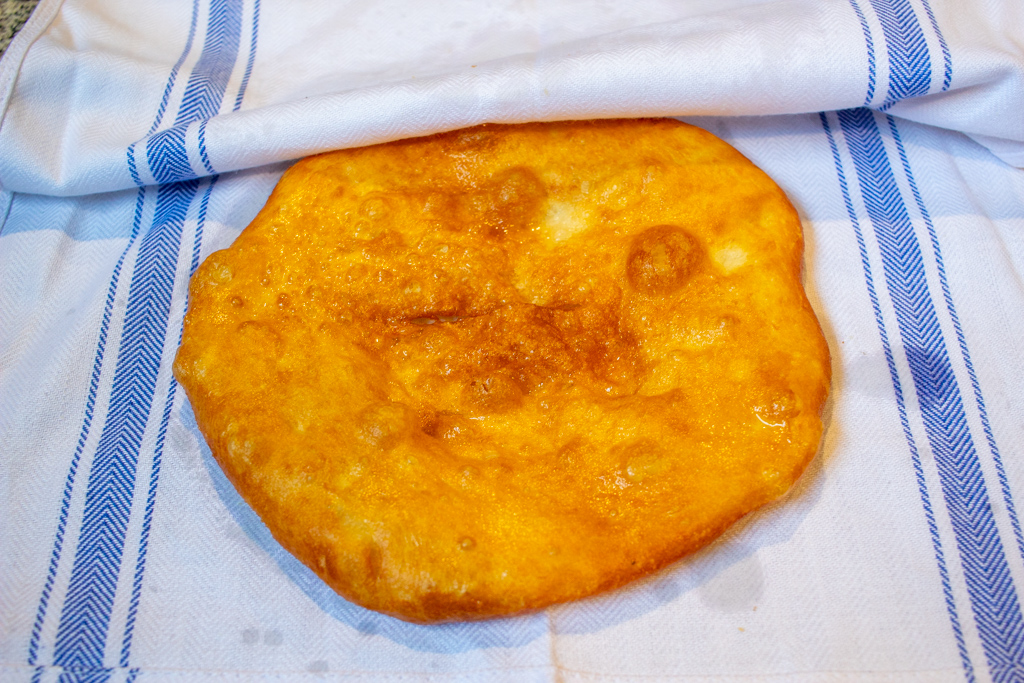
Both were good, but the ones that I slit ended up looking nicer. In either case, working while it’s still hot, sprinkle a little salt over the bread, cut open a clove of garlic, and rub the cut side against the surface of the bread. PROTIP: in this photo, I have the garlic cut lengthwise. That gives you more surface area and it works well for a flat piece of toasted bread, like with Pa amb tomàquet. However, this bread is hot, irregularly shaped, and slippery, and it works better to cut the garlic clove so that you have a longer piece, giving you a better grip and a little distance from the hot oily bread surface.

Then spread one or two spoonsful of sour cream over the surface of the bread

and sprinkle some grated gouda over the top.

This then is lángos in its basic form. If you’ve worked quickly enough the residual heat of the fried bread will begin to melt the cheese, or at the very least soften it considerably. The bread is just a little salty, the crisp-crusted but chewy outer edges giving way to a thin and cracklingly crunchy center. Primarily the flavor is garlic and cheese–Hungarian pizza isn’t far off, despite the lack of tomato sauce.
Some places will serve it garnished with fresh dill. There may be other topping options–ham, mushrooms, bacon, onions.

The red onion has a sweetness and crunch to it, whatever pungency it added to the flatbread simply a grace note to the already-powerful garlic. The thick-cut bacon though is a brilliant addition, smoky, salty, alternately crisp or chewy or both. It doesn’t overwhelm the existing garlic/cheese flavor of the lángos but augments it. Peanut butter and chocolate were two great tastes that taste great together, but I’m pretty sure garlic, cheese, bacon, and fried things are the 4 main essential tastes. Wait, that leaves out hot sauce.

According to Wikipedia, the fried flatbread is known around eastern Europe mostly by variants of the word Lángos.
Lángos is known in the Czech Republic, Slovakia and Croatia as langoš, in Serbia as languš (although it is commonly called “Mekike“). In Slovenia is known as Langaš. In Bulgaria it is known as Mekitsi. It is also popular in Romania (especially in Transylvania) as langoși. It is also extremely popular in Poland where it is known as “langosz” and in the UK where it’s called “langos” or “Hungarian Fried Bread.”
Wikipedia entry on Lángos
But according to another source I found, in Romania it is called Scovergi. And while most of the accounts I’ve read have described mainly savory toppings of garlic and cheese, many have also mentioned sweet possibilities–Nutella, perhaps, or honey, or a simple dusting of powdered sugar.
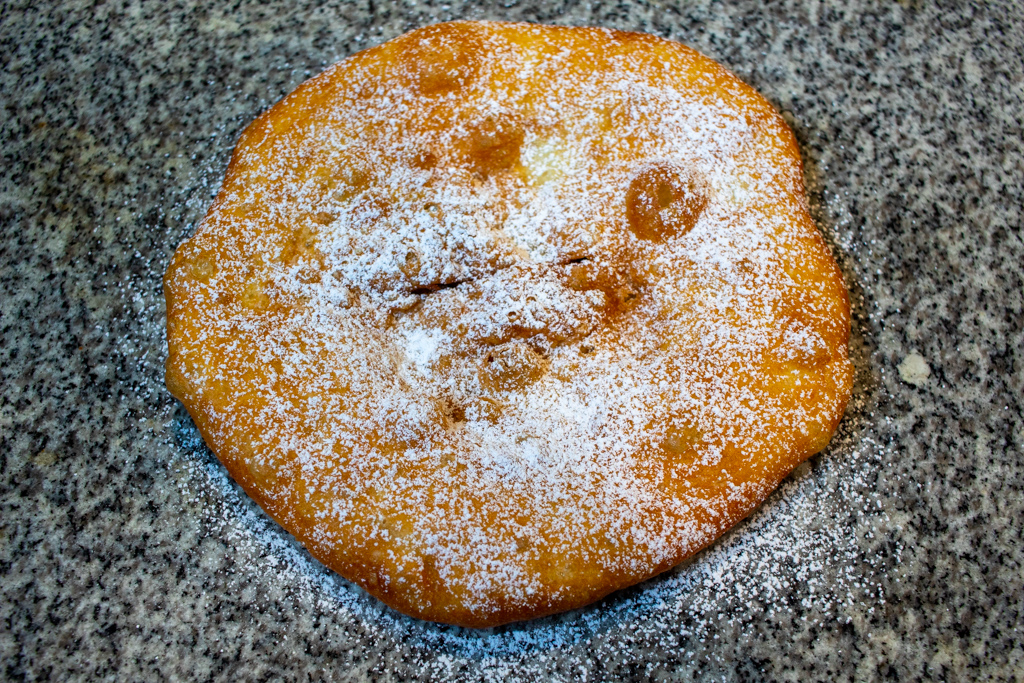
However, perhaps the most common sweet topping for Lángos is jam. Apricot jam would perhaps be the most appropriate for use in a Hungarian treat like this, but raspberry is what I had.
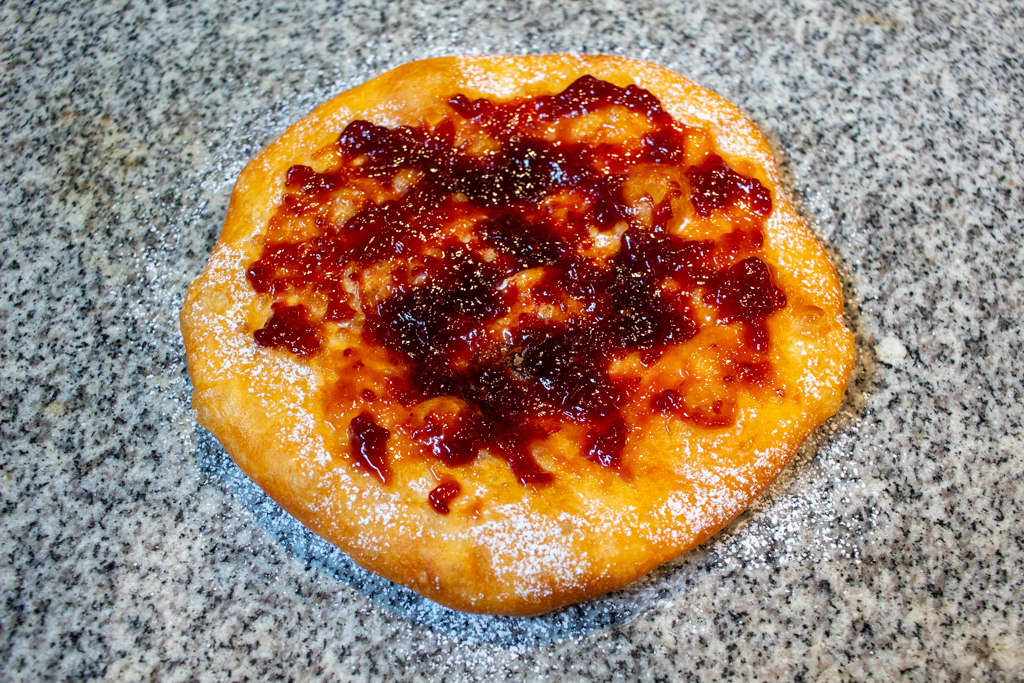
I still had 4 pieces of dough resting in the fridge and no idea what to do with them. Probably the absolute last thing I should do is make and eat more fried dough though, right? Right?
You Ain’t Seen Stuffing Yet
Stuffed lángos appear to be a relatively recent innovation on the basic premise of the formerly baked, now deep-fried street treat. Recipes do not abound on the internet, but the idea is out there, and how difficult could it be to find fillings for what is essentially a savory jelly donut? I’ve had curry-stuffed doughnuts from Japanese bakeries and kimchi-stuffed doughnuts from Korean bakeries, and of course we’ve tried a number of sandwiches made with donuts as bread.





But let’s start simple, shall we?
This Youtube cook is wrapping the flattened, stretched lángos dough around what appear to be some pretty cheap skinless hot dogs along with shredded cheese, then topping the hot dog fritters with the garlic/sour cream/cheese combination typical of a lángos. Sort of a highbrow corn dog? but without corn. A wheatdog? I’m not sure what to call this but I tried it. I used a locally-made natural casing hot dog because I’m fancy that way, but then I used American cheese inside the dough because I’m also a sucker for a super lowbrow cheese dog.



The result was pretty fantastic, I’ll be honest. But the Youtube cook above had the right idea using a cheaper, skinless dog. The snap of the hot dog was superfluous combined with the fried dough surrounding it.

I could have eaten dough-covered deep-fried sausages all day, but I was inspired by a recipe for Lángos stuffed with quark (a sort of fresh, acid-curdled cheese that is more well-known in Europe than in the States), dill, and green onions, and by the knowledge that cheese pastries are almost always the best savory pastries. Greek Spanakopita and Tiropita, Balkan burek, even Georgian Khachapuri, though it generally lacks the spinach, onions, and or herbs components of the others–all these are nearly irresistible to me.
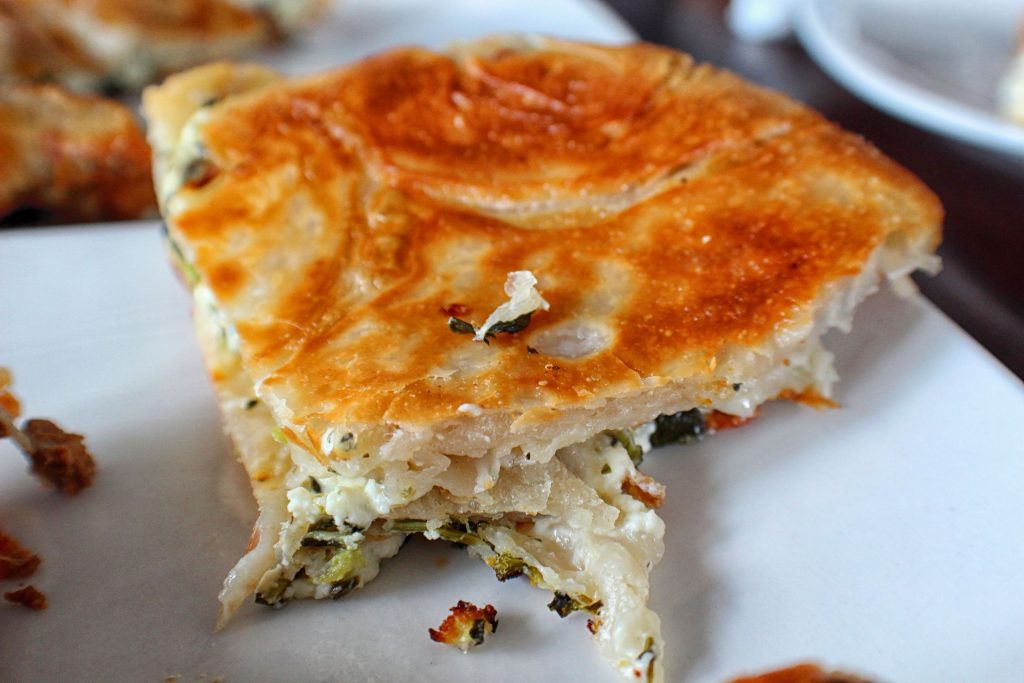
The nearest US equivalent to quark is cottage cheese, so I simply mixed a small amount of cottage cheese with some chopped dill and green onions, seasoned it with a little salt and pepper, piled it onto half a stretched round of Lángos dough and folded it over, sealing the edges. Then I deep fried the entire football-sized mess and topped it with garlic, sour cream, and shredded gouda.




Friends, it may not be much to look at. I overstuffed it, and when I cut it open it leaked whey and bits of cheese herb mix all over the marble. It was good though, stunningly good, just astounding. It didn’t photograph worth a damn but it sure was tasty.
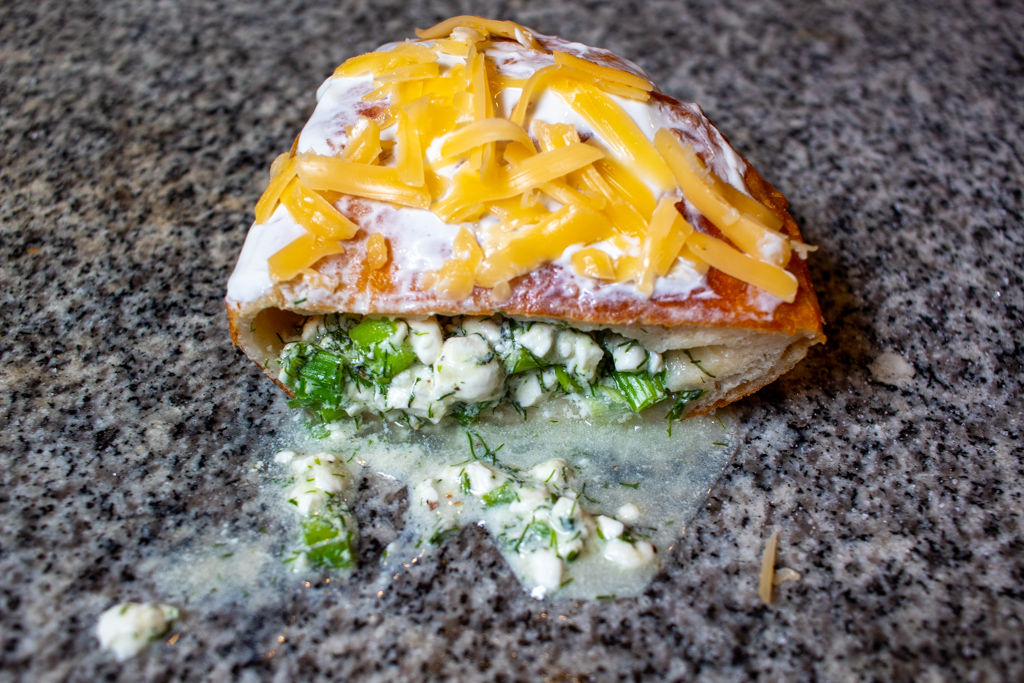
I made more after that. I made one stuffed with ham, garlic, mushroom and cheese that was also excellent, but ever so slightly anticlimactic due to the perfection of the cheese Lángos it was following.




My Big Fat American Lángos
Finally I had one more piece of dough left, and no more ideas. I asked Mindy what she’d like to do with it, and the recipe she came up with was not very Hungarian but it did embody the Sandwich Tribunal principle of “Anything worth doing is worth overdoing.” We started with a freshly fried Lángos flatbread and spread it with just a little butter, then sprinkled it with just a little cinnamon sugar.

Then we topped it with caramelized fresh peaches. Kind of a lot of caramelized fresh peaches, if I’m being honest.
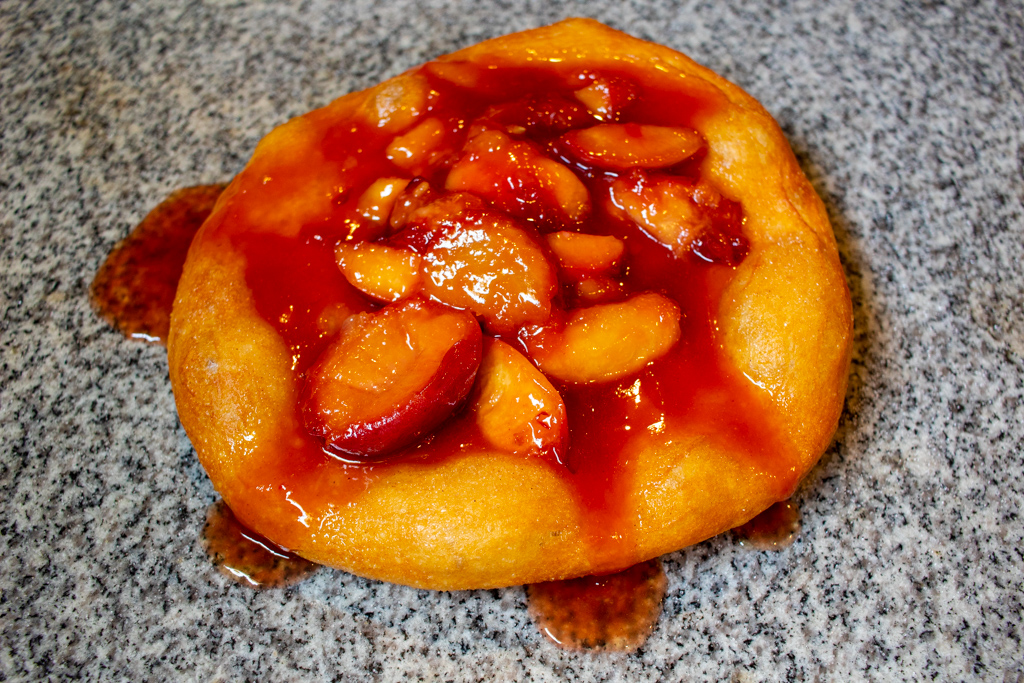
Then we added some hand-whipped cream with just a little bit of almond extract.
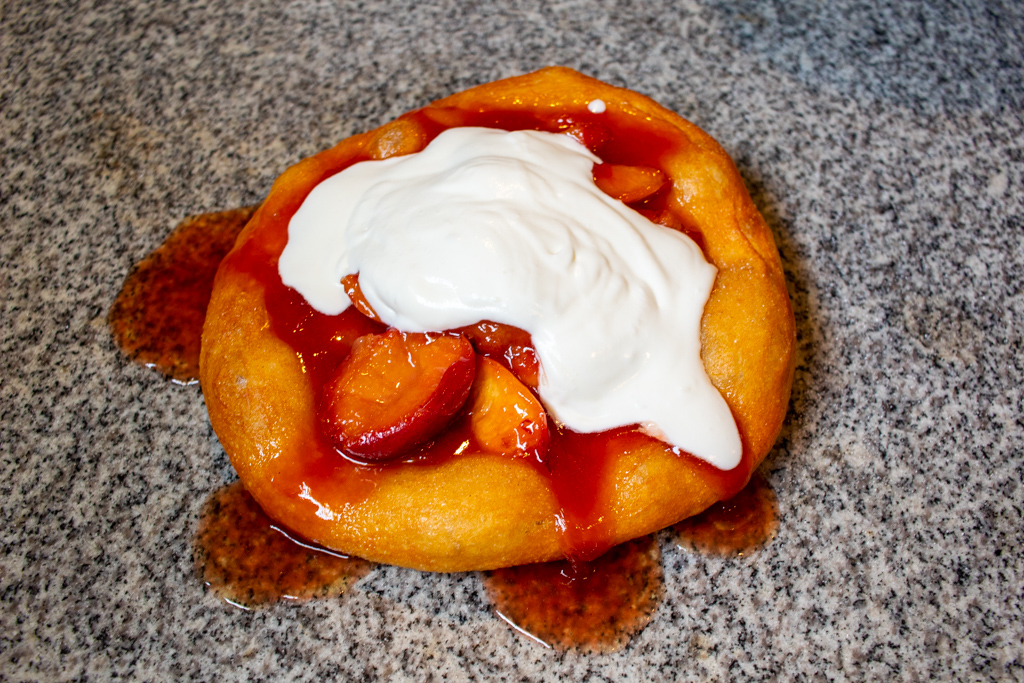
Then we decided it was way too late for restraint and added more of the whipped cream.
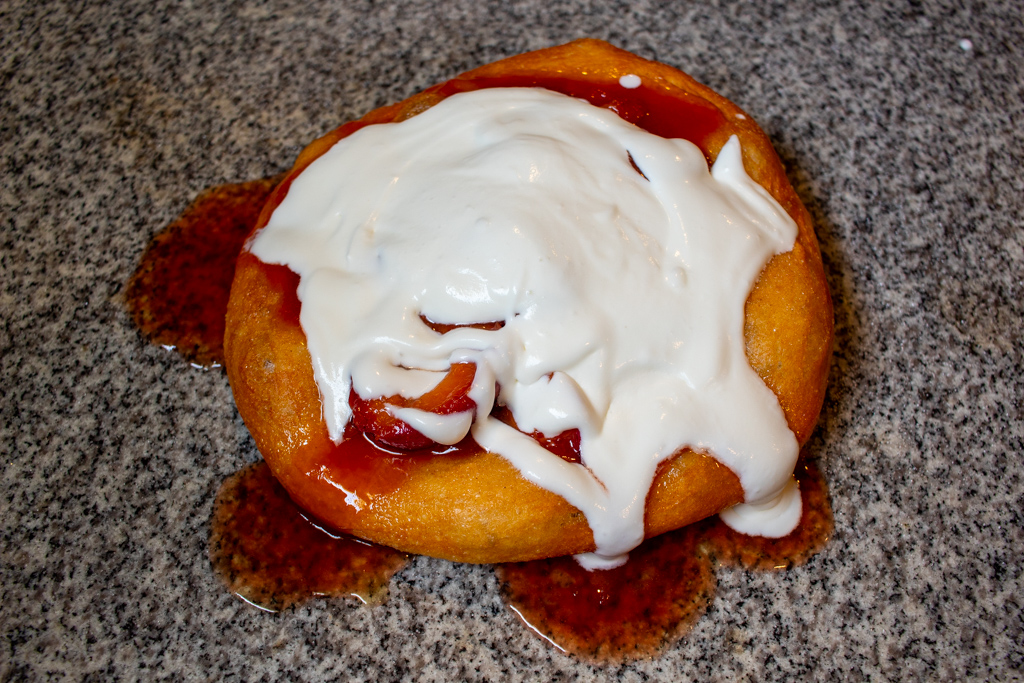
I’m more of a fan of savory toppings than sweet, but the peaches were somewhat tart, and the dough was somewhat salty, and while this was clearly a dessert it seemed to satisfy both savory and sweet tastes at the same time. Just a fantastic idea, Mindy, thanks!
As you can see, we may have overindulged in deep-fried breads over the past week or so, and while I prefer to imagine that I’m immortal and indestructible, all the fat and carbs can’t help but pile up. So I’m putting in a lot of miles on the bicycle this week, and having salads for a few more meals than I generally do, but what a weekend! I don’t recommend eating 8 Lángos in a 2-day stretch the way we just did but I do think it would make for an excellent occasional splurge. Though I’d love to see what they used to look like back when those Hungarian home bakers would throw a snatched corner of dough into the fire for a morning snack. I don’t suppose we have any Hungarian readers, do we? Please tell us your stories of Lángos!

I like sandwiches.
I like a lot of other things too but sandwiches are pretty great


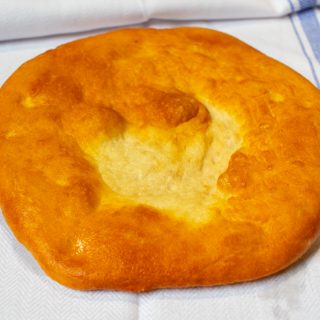



I definitely need to give this recipe a try! We’ve been missing and craving langos, and last month a recipe for langos from Dirndl Kitchen was brought to my attention. I’ve now made it three times in the last month! If you’ve not tried it yet, get to Retro Langos in Budapest one day – hands down our favorite place for langos.
hungarian reader here! as a city girl, i’ve never experiance flame-thrown lángos haha. most of my lángos-memories are tied with summer weeks spent at the Lake Balaton (the biggest lake in hungary) on the beach as a quick lunch or an afternoon snack. a freshly fried piece would be split between me and my sisters and we would be full for hours after. it is truely a national treasure!
the sweet varieties came about in the past few years. i still remember being astounded and a little upset when i saw a street vendor selling some with nutella and bananas. still, we can not stand in the way of development.